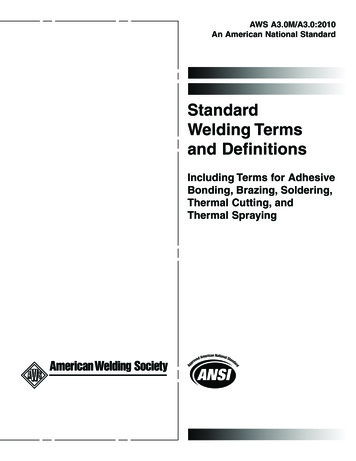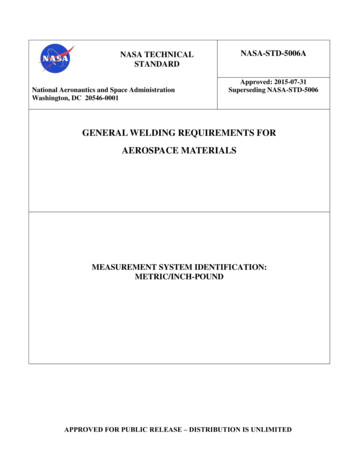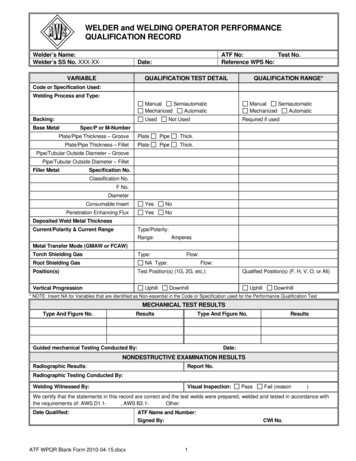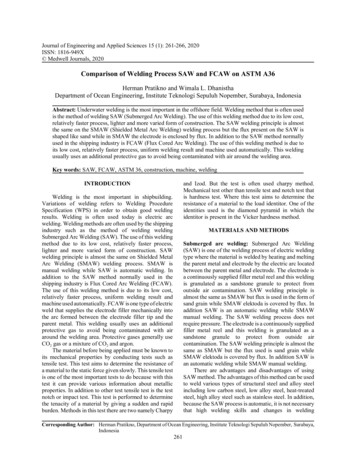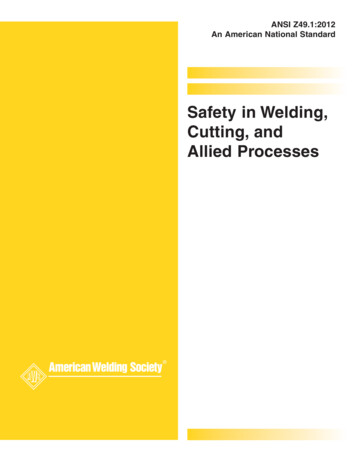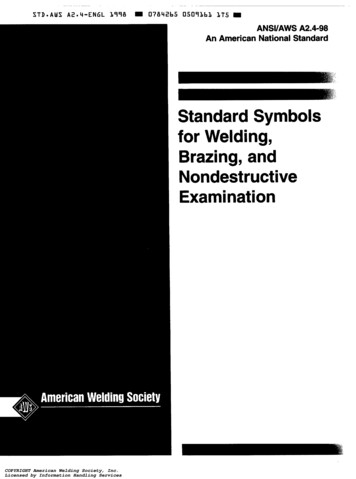
Transcription
COPYRIGHT American Welding Society, Inc.Licensed by Information Handling Services
ANSVAWS A2.4-98An American National StandardKey Words- Weld symbols, welding symbols,brazing symbols, nondestructiveexamination symbolsApproved byAmerican National Standards InstituteNovem ber6,1997Standard Symbols forWelding, Brazing, andNondestructive ExaminationSupersedes ANSIIAWS A2.4-93Prepared byAWS Committee on Definitions and SymbolsUnder the Direction ofAWS Technical Activities CommitteeApproved byAWS Board ofDirectorsAbstractThis standard establishes a method of specifying certain welding, brazing, and nondestructive examination informationby means of symbols. Detailed information and examplesare provided for the construction and interpretation of thesesymbols. This system provides a meansof specifying welding or brazing operations and nondestructive examination,aswell as the examination method, frequency, and extent.American Welding Soclety550 N.W. LeJeune Road, Miami,Florida 33 126COPYRIGHT American Welding Society, Inc.Licensed by Information Handling Services
STD-AUS A2.4-ENGLL998078426505091b3T78Statement on Useof AWS StandardsAI1 standards (codes, specifications,recommended practices, methods, classifications,and guides) of the AmericanWelding Society are voluntary consensus standards that have beendeveloped in accordance with the rulesof the American National Standards Institute. When AWS standards are either incorporated in, or made part of, documents that areincluded in federal or state laws and regulations, or the regulations of other governmental bodies, their provisions carrythe full legal authority of the statute. In such cases, anychanges in those AWS standards must be approved bythe governmental body having statutory jurisdictionbefore they can become a part of those laws and regulations. In all cases,these standards carry the full legalauthority of the contract or other document that invokes the AWS standards. Wherethis contractual relationship exists, changesin or deviationsfrom requirements of an AWS standard must be by agreement between thecontracting parties.International Standard Book Number: 0-87171-524-4American Welding Society,550 N.W. LeJeune Road, Miami, FL 33126O 1998 by American Welding Society.All rights reservedPrinted in the United States of AmericaNote: The primary purpose of AWS is to serve and benefit its members. To this end, AWS provides a forum for the exchange, consideration, and discussion of ideas and proposals that are relevant to the welding industry and the consensusof which forms the basis for these standards.By providing such a forum, AWS does not assume any duties towhich auser of these standards may be required to adhere. By publishing this standard, the American WeldingSociety does notinsure anyone using the information it contains against any liability arising from that use. Publication of a standard bythe American WeldingSociety does not carry with it any right to make, use,or sell any patented items. Users of the information in this standard should make an independent, substantiatinginvestigation of the validity of that informationfor their particular use and the patentstatus of any item referred to herein.With regard to technical inquiries made concerning AWS standards, oral opinions on AWS standards may be rendered.However, suchopinions represent only the personal opinions of the particular individualsgiving them. These individualsdo not speak on behalf of AWS, nordo these oral opinions constitute officialor unofficial opinions orinterpretations ofAWS. In addition, oralopinions are i n f o i a l and should not be used asa substitute for an official interpretation.This standard is subject to revision at any time by the AWS Committee on Definitions and Symbols. It must bereviewedevery five years and if not revised, it mustbe either reapproved or withdrawn. Comments(recommendations,additions,or deletions) and any pertinentdata that may be of use in improving thisstandard are requested and should be addressedto AWS Headquarters. Such comments will receive careful considerationby the AWS Committee on Definitions andSymbols and the authorof the comments will be informed of the Committee’s response to the comments. Guests areinvited to attend all meetings of the AWS Committee on Definitions and Symbols to express theircomments verbally.b e d u r e s for appeal of an adverse decision concerning all such comments are providedtheinRules of Operation of theTechnical ActivitiesCommittee. A copy of these Rules can be obtained from the American Welding Society,550 N.W.LeJeune Road, Miami,FL 33126.Photocopy RightsAuthorization to photocopy items for internal, personal, oreducational classroom use only, or the internal. personal, oreducational classroom use only of specific clients, grantedisby the American WeldingSociety (AWS) provided that theappropriate fee ispaid to the Copyright ClearanceCenter, 222 Rosewood Drive, Danvers, MA 01923, Tel: HT American Welding Society, Inc.Licensed by Information Handling Services
PersonnelAWS Committee on Definitions and SymbolsR. L. Holdren, ChairmanEdison Welding InstituteCanadian Welding BureauMorraine Valley Community CollegeAmerican Welding SocietyITW Welding Products CompanyConsultantNewport News ShipbuildingGeneral Dynamics Armament SystemsHobart InstituteElliott CompanyOhio State UniversityAshland Chemical CompanyPacker EngineeringDean Lally L PConsultantWelding EngineeringServicesNational Board of Boiler and Pressure VesselInspectorsConsultantCompositools, IncorporatedSteel Detailers and DesignersJ. J. Vagi ConsultantA. J. Kathrens, Ist Vice ChairmanJ. E. Greer; 2nd Vice ChairmanC. B. Pollock, SecretaryL. J. BarleyH. B. CaryJ. F! Christein*G. B. CoaresC. K. Ford*K. W FordyceW L. GreenB. B. GrimmettM. J. Grycko, JsJ. G. GuentherE. A. Hanvart*M. J . HouleR. D. McGuire*D. H. OrtsL. J. SiyJ. J. StanczakJ . J. VagiAWS Subcommitteeon SymbolsCanadian Welding BureauNational Boardof Boiler & Pressure Vessel InspectorsAmerican Welding SocietyITW Welding Products CompanyNewport News ShipbuildingGeneral Dynamics Armament SystemsHobart InstituteOhio State UniversityDean Lally L PConsultantCompositools, IncorporatedSteel Detailers ¿?c DesignersA. J. Kathrens, ChairmanR. D. McGuire, 1st Vice ChairmanC. B. Pollock, Secretary*L. J. BarleyJ. P. Christein*G. B. CoatesC. K. FordW L. GreenJ. G. GuentherE. A. HanvartL. J. SiyJ. J. Stanczak*Advisor.111COPYRIGHT American Welding Society, Inc.Licensed by Information Handling Services
STDmAWS A2.4-ENGL07842b5 0509Lb5 840 HL998Foreword(This Foreword is nota part of ANSUAWS A2.4-98, Standard Symbols f o r Welding, Brazing, and NondestructiveExamination, but is included for information purposes only).Welding cannot takeits proper placeas a fabricating tool unless means are providedfor conveying the information fromthe designerto the welding personnel. Statements such asbe“towelded throughout”or “to be completely welded,”in effect,transfer the design responsibility from the designer to the welder, whobecannotexpected to know design requirements.These symbols provide the means for placing welding, brazing, and examination information on drawings. The system for symbolic representation of welds on engineering drawings used in this standard is consistent with the “thirdangle” method of projection. This is the method predominately used in the United States. In practice, many companieswill need only a few of thesymbols and, if they desire, can select only the partsof the system that fit their needs.In the past, the use of the words, “far side” and “near side” in the interpretation of welding symbols has led to confusion because when joints are shown in section, all welds areequally distant from thereader and the words“near” and“far” are meaningless. In the present system, the joint is the basis of reference. Any weldedjoint indicated by a symbolwill always have an “arrow side” and an “other side.” Accordingly, the terms armw side, other side,and both sides areused hereinto locate the weld with respectto the joint.The tail of thesymbol is used for designating the welding andcutting processes, as well as the welding specifications,procedures, or the supplementary information to be used in making the weld. When only the size and type of weld arespecified, the information necessary for making that weld is limited. The process, identification of filler metal that is tobe used, whetherpeening, root gouging, or other operations are required, andother pertinent data, should be known. Thenotation to be placed in the tail of the symbol indicating these data will usually beestablished by each user.Symbols in this publication are intended to be used to facilitate communications among designer, shop, and fabrication personnel. The usual limitations included in specifications and codes are beyond the scope of this standard.Illustrations included with the text are intended to showhow correct applications of symbols may be usedtoconvey welding or examination information and are not intendedto represent recommended welding or designpractice.Part B, Brazing Symbols, uses the same symbols for brazing that are used for welding.Part C, Nondestructive Examination Symbols, establishes symbols to be used on drawings to specify nondestructiveexamination for determining the soundness of materials. The nondestructive examination symbols included in the standard represent nondestructive examination methods as discussed in the latest edition of AWS publication B 1.10, Guidef o r the Nondestructive Inspection of Welds. Definitions and details for use of the various nondestructive examinationmethods arefound in AWS B 1.10.AWS A2.4 came into existence in 1976 as the result of combining and superseding two earlier documents A2.0, Standard Welding Symbols, and A2.2, Nondestructive Testing Symbols. Both of the earlier documents had their origins inwork done jointly by the American Welding Society and ASA Sectional Committee Y32. A2.0 was first published in1947 and revised in 1958 and 1968; A2.2 first appeared in 1958 and was revisedin 1969.AWS A2.4-76, Symbols for Welding and Nondestructive Testing, was thefirst version ofthe combined documents andwas preparedby the AWS Committee on Definitions andSymbols. It was revised in1979 as A2.4-79, Symbols f o r Welding and Nondestructive Testing, Including Brazing and revised againin 1986 with the title, Standard Symbols for Welding, Brazing, and Nondestructive Examination. ANSIIAWS A2.4-98 is the second revision of the 1986 document andhas the same title.Official interpretations of any of the technical requirementsof this standard may beobtained by sending a request, inwriting, to the Managing Director, TechnicalServices, American Welding Society.A formal reply will be issued after ithas been reviewed by the appropriate personnel following established procedures. Users of this standard are invited tosuggest additional symbols or revisions for consideration by the committee. These suggestions should be addressed tothe Secretary, Committee on Definitions and Symbols, American Welding Society, 550 N.W. LeJeune Road, Miami,Florida 33126.ivCOPYRIGHT American Welding Society, Inc.Licensed by Information Handling Services
07842b50507Lbb787STDOAWS A 2 - 4 - E N G L I1778Table of ContentsPage No.Personnel .Foreword .List of Tables .List of Figures .iv.v111.v111Part A- Welding Symbols .11111. Basic Symbols .1 .1 Distinction Between Weld Symbol and Welding Symbol .1.2 Weld Symbols .1.3 Welding Symbols .1.4 Supplementary Symbols .1.5 Placement of Welding Symbol .1.6 Illustrations .11111112.Basic Types of Joints.43.General Provisions .3.1 Location Significance of Arrow .3.2 Location of Weld with Respect to Joint .3.3 Orientation of Specific Weld Symbols .3.4 Break in AKOW .3.5 Combined Weld Symbols .3.6 Multiple AKOW Lines.3.7 Multiple Reference Lines .3.8 Field Weld Symbol .3.9 Extent of Welding Denoted by Symbols .3.10 Weld-All-Around Symbol .3.11 Tail of the Welding Symbol.3.12 Contours Obtained by Welding .3.13 Finishing of Welds.3.14 Melt-Through Symbol .3.15 Melt-Through with EdgeWelds .3.16 Method of Drawing Symbols.3.I7 U.S. Customary and Metric Units.3.18 Weld Dimension Tolerance.3.19 Changes in Joint Geometry During Welding.44Groove Welds .4.1 General . o;.4.2 Depth of Bevel and Groove Weld Size .4.3 Groove Dimensions .4.4 Length of Groove Welds.4.5 Intermittent Groove Welds .4.6 Contours and Finishing of Groove Welds .4.1 Back and Backing Welds .4.8 Joint with Backing .4.9 Joint with Spacer.212122232424254.VCOPYRIGHT American Welding Society, Inc.Licensed by Information Handling Services455566677788889999252626
STDmAWS A2.4-ENGL3998W 078426505093676134.10 Consumable Inserts .4.1 1 Groove Welds with Backgouging4.12 Seal Welds .4.13 Skewed Joints .272727275.Fillet Welds . 505.1 General.505.2 Size of Fillet Welds.505.3 Length of Fillet Welds . 3 05.4 Intermittent Fillet Welds . 515.5 Fillet Welds in Holes and Slots.515.6 Contours andFinishing of Fillet Welds. 51515.7 Skewed Joints .6.Plug Welds .6.1 General .6.2 Plug Weld Size.6.3 Angle of Countersink.6.4 Depth of Filling .6.5 Spacing of Plug Welds .6.6 Number of Plug Welds.6.7 Contours and Finishing of Plug Welds .6.8 Joints Involving Three or More Members.5656565656565657577.Slot Welds .7.1 General .7.2 Width of Slot Welds .7.3 Length of Slot Welds .7.4 Angle of Countersink.7.5 Depth of Filling .7.6 Spacing of Slot Welds .7.7 Number of Slot Welds .7.8 Location and Orientation of Slot Welds .7.9 Contours and Finishing of Slot Welds .616161616161616262628.Spot Welds .8.1 General .8.2 Size or Strength of Spot Welds .8.3 Spacing of Spot Welds .8.4 Number of Spot Welds .8.5 Extent of Spot Welding .8.6 Contours andFinishing of Spot Welds .8.7 Multiple-Member Spot Welds .65656565666666669.Seam Welds .9.1 General .9.2 Size and Strength of Seam Welds.9.3 Length of Seam Welds .9.4 Dimensions of Intermittent Seam Welds .9.5 Number of Seam Welds .9.6 Orientation of Seam Welds .9.7 Contours and Finishing of Seam Welds.9.8 Multiple-Member Seam Welds .72727272737373737310. Edge Welds. 7810.1 General.10.2 Edge Weld Size .COPYRIGHT American Welding Society, Inc.Licensed by Information Handling Services7878
STDmAWS A2.4-ENGL10.310.410.510.610.71998 07842b50509168 5 5 TSingle- and Double-Edge Welds.Edge Welds Requiring Complete Joint PenetrationEdge Welds onJoints with More Than' b o Members .Lengthof Edge Welds.Intermittent Edge Welds.787878787811. Stud Welds .11.1 Side Significance.11.2 Stud Size .11.3 Spacing of Stud Welds.11.4 Numberof Stud Welds.11.5 Dimension Location.11.6 Location of First and Last Stud Welds8282828282828212. Surfacing Welds .12.1 Use of Surfacing Weld Symbol .12.2 Size (Thickness) of Surfacing Welds.12.3 Extent, Location, and Orientationof Surfacing Welds.12.4 Surfacinga Previous Weld .12.5 Surfacing to Adjust Dimensions.828282838383Part B-Brazing Symbols . 8313. Brazed Joints .83Part C-Nondestructive Examination Symbols .89.14. Elements of the Nondestructive Examination Symbol14.1 Examination Method Letter Designations.14.2 Supplementary Symbols.14.3 Standard Locationof Elements of a Nondestructive Exami
work done jointly by the American Welding Society and ASA Sectional Committee Y32. A2.0 was first published in 1947 and revised in 1958 and 1968; A2.2 first appeared in 1958 and was revised in 1969. AWS A2.4-76, Symbols for Welding and Nondestructive Tes


